Shipwrecks of the Great Lakes: The Storm of 1913, Part Two
Note: From 6/9/22 through 6/22/22, you can get a free 386-page PDF of Exploring Michigan’s Sunset Coasts. Go to author Julie Royce’s website at www.jkroyce.wordpress.com. Click the button on the sidebar and provide your email. Your email will be deleted once the book is sent. If you like the book, tell your friends and suggest they get the free PDF or buy the book on Amazon. Better yet, if you like it, write a review on Amazon. Let’s promote Michigan!
Plan ahead: from 6/23/22 to 6/29/22, Royce will offer a free PDF of Exploring Michigan’s Sunrise Coasts, from 6/30/22 to 7/6/22, she will offer a free PDF of Exploring Michigan’s Upper Peninsula Coasts, and from 7/7/22 to 7/13/22, she will offer a free PDF of Exploring Michigan’s Sunset Coasts. Read our author interview about all three books here.
The approximate 6,000 ships that have succumbed to raging storms attest to the power of the Great Lakes. As I traveled, writing and compiling information for my three-volume travel series, Exploring Michigan’s Coasts, I heard or read the tales left behind by those ill-fated ships. They add a somber, but compelling backdrop to Michigan’s waterways.
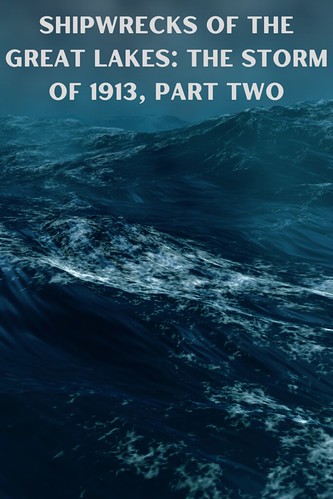
The Storm of 1913 claimed 8 freighters and 178 lives in Lake Huron. The number of victims would have been greater if the ships had carried passengers. These were cargo ships, and the crew of the largest numbered 28. Two sets of twin ships perished: the Charles S. Price and her sister ship the Isaac M. Scott, and the Argus and her sister ship the Hydrus.
The eight ships that perished in Lake Huron during the storm of 1913:
Vessel Lives Length Capacity Value
Lost in Feet in tons in 1913
Charles S. Price 28 524 9,000 $340,000
Isaac M. Scott 28 524 9,000 $340,000
James Carruthers 19 550 9,500 $410,000
Wexford 17 270 2,800 $125,000
Regina 15 269 3,000 $125,000
John A. McGean 23 452 7,500 $240,000
Argus 24 436 7,000 $130,000
Hydrus 24 436 7,000 $130,000
The H. M. Hanna Jr. and the Matoa were also deemed total constructive losses, but because they made it to shore, there was no loss of life.
The following is the best account available of what happened to each of the great ships that perished.
The Charles S. Price was seen by Captain A.C. May of the H.B. Hawgood on Sunday afternoon, November 9. Captain May had steered his ship some distance up Lake Huron before he realized the enormity of the weather conditions. He hauled around and started back for the relative safety of the St. Clair River. Near Harbor Beach, he saw the Price. She was moving north toward the worst of the storm.
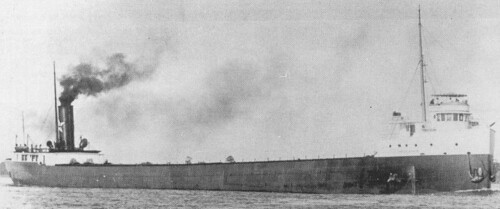
SS Charles S. Price
It is clear that at some point the Price, too, turned around, because her remains were found close to the entry of the St. Clair River at Port Huron. Observers believe if she had managed to get an additional 15 miles behind her, she might have survived. Instead, she was one of the great ships to “turn-turtle.”
On Monday morning, November 10, Captain Plough of the Lakeview Lifesaving Station above Port Huron searched the tossing water with his telescope and spied what appeared to be the hull of a vessel. There were no masts or smokestack. Plough called Captain Tom Reid of the Reid Wrecking Company in Sarnia, who in turn, sent a big tug to investigate.
Reid confirmed that a huge, flat-bottomed freighter was flipped upside-down. The bow was about 30 feet out of the water, but the stern was submerged. It was not possible to tell the length of the ship, nor could its identity be established, as the hull looked exactly like the hull of many other ships.
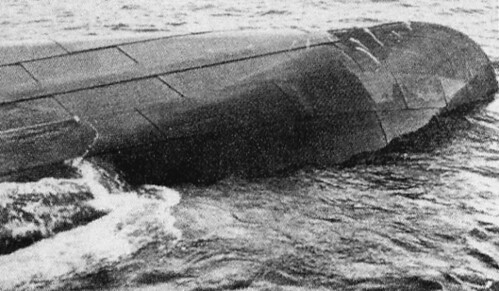
SS Charles S. Price upside down north of Port Huron, Michigan, after the Great Lakes Storm of 1913
For six days, she remained a mystery ship amid speculation that it was the Regina, the James C. Carruthers, or the Wexford. Finally, William Baker, a diver from Detroit, plunged into the icy waters, worked his way around the hull, clutching the railings above him, and found the nameplate. He checked it twice to be sure. There was no indication of a collision, and there was no other vessel trapped under its bow. The wrecked boat’s peculiar position was caused by trapped air that was escaping in a tiny, slow stream of bubbles. All doubt was gone. It was the Charles S. Price.
The Price sank from sight on November 17, eight days after she had been tossed upside down by the monstrous sea.
For one woman, awaiting the news identifying the mystery ship, it was the end of uncertainty, but also the end of hope. She was the wife of second mate, Howard Mackley, and she finally knew her husband’s fate. When the ship had passed Detroit early on Sunday morning, her husband had posted a letter to her. When the Price was abreast their home in St. Clair, he pulled the whistle in customary salute. Mrs. Mackley was there waiting to wave a response greeting. She watched his ship travel upriver until it was out of sight, unaware it was the last time they would perform their loving ritual.
For assistant engineer Milton Smith, who had looked at the weather forecast in Cleveland and decided to sit this one out, there was the relief of simply being alive. He had felt uneasy about the trip for days, and tried to talk his friend and neighbor, wheelsman Arz McIntosh, into leaving with him, but McIntosh insisted he needed the money.
Of all of the ships that went down that terrible night, it was the Price that caused the most concern. No one believed a bulk freighter with its wide flat-bottom could possibly be flipped over and sunk like a toy boat in a bathtub.

SS Charles S. Price
The Isaac Scott was also spotted by Captain A.C. May, as he headed for safety at the foot of the lake. Captain May encountered the Scott about five or six miles north of the Port Huron Lighthouse at approximately 3:30 p.m. on Sunday. May later described his feeling that the Scott’s captain had been a fool to leave the St. Clair River, the very destination for which May was headed. It seemed inconceivable that the Scott’s captain would make for the open waters of the storm-churned lake.
The Scott foundered farther up Lake Huron, near Pointe aux Barques. Relatively little sign of her was immediately found, other than one empty lifeboat with its canvas covering still intact. The lack of drifting bodies and artifacts suggested she capsized quickly, without providing the crew enough warning to make even vain attempts to avoid certain death.

SS Isaac M. Scott
The James C. Carruthers was a Canadian ship making her third voyage. Because the captain’s name was William H. Wright, and the manager of Marine Affairs for the company owning her was also named Wright, the boat was nicknamed the “All-Wright boat.”
For three days after the storm, panicked family members and the ship’s owner waited for the final word of whether the Carruthers was lost. Evidence began drifting in—a lifejacket, an oar, a piece of debris believed to have been part of her cabin. Bodies began appearing and quashed lingering hopes. The ship’s owner predicted they would never find Captain Wright, who under all circumstances would go down with his ship. Perhaps more astonishing is that the Carruthers has never been found.
One amazing story of survival came out of the sinking of the Carruthers. Days after the storm, Thomas Thompson was summoned to Goderich by his daughter, Mrs. Edward Ward of Sarnia. She told her father that she had just identified the body of her brother, John Thompson. The elder Mr. Thompson arrived, and like his daughter, identified his son’s body. The waters may have been unkind, but there was no mistaking the J.T. tattoo, the scars on his nose and leg, and the two deformed toes. Father and daughter set about making funeral arrangements.
Meanwhile, in Toronto, John Thompson was surprised to read about his death in the newspaper. Without calling, he hopped a train for Sarnia and arrived in time to crash his own funeral! He had not been aboard the ill-fated Carruthers.

SS James Carruthers
The Wexford spewed its bodies and cargo on the Canadian shores. Even after the snows melted, the beaches were white with her 96,000 bushels of spilled grain. The Wexford remained invisible for eighty-seven years, until she was finally discovered in 2000 near Grand Bend, Ontario.
Out of every natural disaster, there is always one story of someone lucky enough to have missed a train, a plane, or in this case, a ship that meets tragedy. During this storm, it was James McCutcheon, a sailor on the Wexford. After the storm, he was among the small army of people who rushed to the lakeshore to identify bodies. He had missed the train to Sarnia, where he planned to board the Wexford. McCutcheon had been late and missed his ship on only three occasions in his life. The first time the ship caught fire and sustained heavy casualties. The second time the ship was wrecked and suffered a heavy loss of lives.
As he stood surveying the bodies of his dead shipmates, he uttered the understatement of the disaster, “I’m the luckiest guy alive.”

SS Wexford
The Regina went down in mystery and speculation. The bodies of crewmen from the Price and the Regina floated to shore together. Sometimes the waves threw them into each other’s arms. Twelve men, later identified as being from the crew of the Price, were found wearing the life jackets of the Regina. The explanation that makes the most sense is that the two ships collided before sinking, and in those moments before they went under, men slipped and slid from the deck of one doomed ship to the other. Perhaps believing one ship might survive, some crewmen may have jumped to the more stable of the two. During the pandemonium that must have broken out, men likely grabbed whatever life preservers were available with no consideration for which ship it came from.
If a collision did take place, one of the ships had to limp for many miles before going under, since the Price was found in Port Huron, and the Regina was found 30 miles farther up lake between Lexington and Port Sanilac.
The Regina may have been the most ill-equipped vessel to venture forth and vanish in the Great Storm. When it was all over, it would not have made a difference. She was making her last trip for the season, and Captain McConkey was eager to get home to his wife and two daughters. At Sarnia, he picked up a heavy load of iron pipe that was lashed to his deck before he headed into Lake Huron. His ship’s broken communication equipment prevented him from knowing how severe the storm warnings were. It is believed that the ship made it as far as Saginaw Bay when the brutal winds forced her to turn back.
Water began to freeze everywhere on the ship. The crew put on life preservers and readied the lifeboats. By 11:00 p.m., the captain was the only man left on the ship. People on shore heard his mayday pleas, but in the face of 90-mile-an-hour winds and 35-foot waves, they were helpless to offer any assistance. The captain was a frightened 34-year-old husband and father who only wanted to see his family again. His body was found 9 months later, along with his watch and his diary. He was the last of the crew to be found. His ship was not found for 73 years.
Missing from the Regina when she sank was George Gosby. Three weeks earlier, Gosby stumbled over a hatch cover and fell into the hold as the Regina was loaded. Initially feeling sorry for himself for having to sit out the remainder of the season, he had reason to consider it his lucky break.

SS Regina
The John A. McGean foundered and sank about 75 miles north of Port Huron and slightly north of Harbor Beach. The McGean was captained by the colorful Dancing Chauncey Ney, who as his nickname suggests, loved to dance. He liked to be in port on Friday and Saturday nights so he could catch the local dances. He never left the dance floor until the band played its last tune.
One of the McGean’s life rafts drifted onto the beach with its gruesome crew of three dead men lashed to it. A second McGean raft carried a single body. The frozen bodies of most of the remaining crew were found washed ashore and scattered randomly along the sand and rocks. A few remained, bobbing in the water. All were accounted for...except Chauncey Ney, whose last dance partner was an angry Lake Huron.

SS John A. McGean
The Argus was the only ship to sink that day before the eyes of horrified witnesses. Captain Walter C. Iler of the steamer George C. Crawford was fighting his own battle on the rogue and rampaging sea when he witnessed a scene he would remember forever. Captain Iler was attempting to turn his huge vessel around but meeting with little success when a temporary lull in the wind helped him right his ship and escape the raging waters. Sometime late Sunday afternoon, between snowy whiteouts, he caught sight of the Argus laboring strenuously beneath her heavy load of coal. Her bow and her stern appeared suspended by huge waves going in different directions, leaving the cargo-heavy midsection unsupported in the gap between the waves. Ile watched her crumble like an eggshell and disappear.
Captain Paul Gutch of the Argus washed ashore with no lifejacket. Mrs. William Walker was a second cook on the Argus. When her body floated out of the water, she wore the lifejacket marked Captain—likely an unselfish act of heroism, but for naught. No life jacket protected against the whirling white waters made foamy by ice and snow.
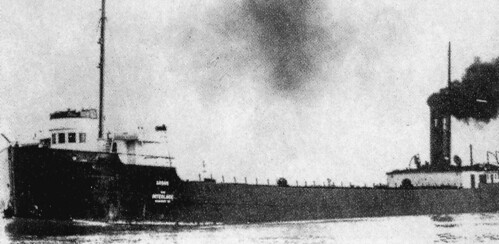
SS Argus
The Hydrus, twin sister ship to the Argus, was the ship with the worst recovery rate for bodies. Several are believed to have washed onto the rocky shores of the Saugeen Native American Reservation. Speculation suggested that the Native Americans, because of cultural beliefs, were hesitant to touch the bodies. Shifting winds and currents may have carried some of the dead to places where no one would find them. Two lifeboats with bodies of seamen from the Hydrus were recovered, but it was 102 years before the wreckage of the Hydrus revealed itself.
In the storm’s aftermath, several bodies washed ashore with watches still on the victims’ wrists. Many of the watches stopped between 8:00 p.m. and 11:00 p.m. on Sunday, November 9. The weather bureau reported that the highest winds on Lake Huron came between 6 and 8 o’clock that evening.

SS Hydrus
While Lake Huron buried many secrets beneath her turbulent waves that awful night, she did give up another. Near Harbor Beach, fishermen found a body and wreckage from a tug, the Searchlight, which had vanished with all hands aboard in 1908. The violent storm had unearthed her watery grave.
Less than a year after the big storm, the Great Lakes offered a possible demonstration of how those freighters capsized in November 1913. On May 8, 1916, the S.R. Kirby sank in a relatively modest storm. The Kirby (found in 2019) was regarded as seaworthy, but she sank almost without warning. The investigation revealed that a great wave crashed over the port bow, submerging the deck. The weight of the water pushed the bow downward and tipped the stern high in the air. Before the Kirby righted herself, a second wave came at her and stood the boat in a position with her hull poised out of the water. A third deadly wave then caught her from beneath. She heaved upward, stood motionless for thirty seconds, and then plunged to the bottom.
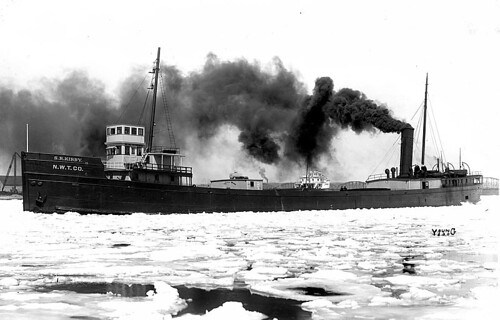
S.R. Kirby
Captains of the ships that managed to get ashore during the Storm of 1913 reported their vessels being struck by waves coming from all directions.
Immediately after the Storm of 1913, the death count and human suffering were foremost on everyone’s mind. Later, it became apparent that the White Hurricane had also destroyed one of the Thumb’s major industries. Docks crumbled at Harbor Beach, Lexington, Forester, and Port Sanilac. They were never rebuilt. The great cargo freighters no longer stopped at these small towns. The transportation of goods moved inland to the railroad. Shipping and transportation in the Thumb had changed forever.
Today, meteorologists would call the Storm of 1913 a weather bomb. To many of the Thumb’s people, it was the end of the world as they had known it.
Learn more:
Click through to read excerpts from Royce's three books exploring Michigan's coasts:
Julie Albrecht Royce, the Michigan Editor for Wandering Educators recently published a three-book travel series exploring Michigan’s coastlines. Nearly two decades ago, she published two traditional travel books, but found they were quickly outdated. This most recent project focuses on providing travelers with interesting background for the places they plan to visit. Royce has published two novels: Ardent Spirit, historical fiction inspired by the true story of Odawa-French Fur Trader, Magdelaine La Framboise, and PILZ, a legal thriller which drew on her experiences as a First Assistant Attorney General for the State of Michigan. She has written magazine and newspaper articles, and had several short stories included in anthologies.

Books available on Amazon
All ship photos in the Public Domain, courtesy Wikimedia Commons




















